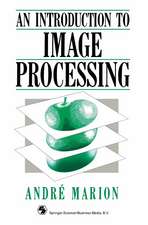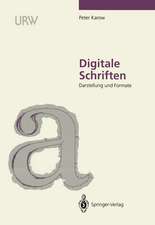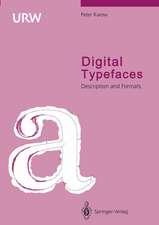Font Technology: Methods and Tools
Autor Peter Karowen Limba Engleză Paperback – 15 dec 2011
Preț: 345.59 lei
Preț vechi: 431.98 lei
-20% Nou
Puncte Express: 518
Preț estimativ în valută:
66.15€ • 71.88$ • 55.60£
66.15€ • 71.88$ • 55.60£
Carte tipărită la comandă
Livrare economică 22 aprilie-06 mai
Preluare comenzi: 021 569.72.76
Specificații
ISBN-13: 9783642785078
ISBN-10: 3642785077
Pagini: 476
Ilustrații: XIV, 457 p.
Dimensiuni: 170 x 242 x 25 mm
Greutate: 0.78 kg
Ediția:Softcover reprint of the original 1st ed. 1994
Editura: Springer Berlin, Heidelberg
Colecția Springer
Locul publicării:Berlin, Heidelberg, Germany
ISBN-10: 3642785077
Pagini: 476
Ilustrații: XIV, 457 p.
Dimensiuni: 170 x 242 x 25 mm
Greutate: 0.78 kg
Ediția:Softcover reprint of the original 1st ed. 1994
Editura: Springer Berlin, Heidelberg
Colecția Springer
Locul publicării:Berlin, Heidelberg, Germany
Public țintă
Professional/practitionerCuprins
Directory.- 1. Introduction.- 2. Computer, like you and me.- Competition for the designer.- Putting type through the mincer.- Big shots.- Splines.- Big brother.- Programmers.- Machine control.- The art of math.- In brief.- Open questions to GGL.- Statistics.- Kerning.- Trapping (shrinking and spreading).- Kanji Metafont.- Sukeringu.- Machine formats.- Management.- 3. Typeface Market.- Typefaces are digital.- Standards and work division.- Typeface standards.- Areas for application of typefaces.- Typeface prices.- Typeface market.- Summary.- 4. Font Production in past and present.- 5. Third Abstraction.- Programmer’s estimations.- 6. Font Technology.- Hand-digitizing.- Originals.- Designing on the screen?.- Quality.- Database.- 7. Intelligent Font Scaling.- Commentary.- List of instructions.- Rating the various scaling techniques.- Kind of contour description.- Conversion speed.- Memory requirements for a font.- Supported font layout.- Supported font metrics.- General output quality.- Effects of scaling techniques on font production.- Number of available fonts.- Future improvements for scalers: Universal RIPs.- Future screen fonts.- Glossary of instructions.- Employee and employer.- 8. Effects of Rasterization.- Resolution capability of the human eye.- Representation of a typeface.- DTP of the future.- 9. Letter Spacing.- Inter-letter spaces.- Legibility and discriminability.- Traditional spacing.- First step-basic spacing.- Optical center.- Italic typefaces and serifs.- Test texts and alphabet length.- Block composition.- Units.- Kerning - exceptions are becoming the rule.- Kerning tables.- Aesthetic tables.- Long kerning.- Short kerning.- 10. Display, Text and Poster.- Text.- Display.- Notices and advertisements.- Poster.- Graphics.- Resolving power of the human eye.-Graphic arts.- The fiddler.- 11. Type Quality.- What is it that accounts for the quality of a type?.- What is quality?.- Craftsmanship.- A range of design sizes.- Optical scaling.- In conclusion.- 12. Legibility.- What do we mean by legibility?.- Reading as a confirmation of expactations.- Some early approaches to the study of legibility.- Early definitions of legibility and discriminability.- The most important methods of studying legibility and discriminability.- The separation of «legibility» and «discriminability».- Speed-of-reading as a criterion of legibility.- Requirements for a legibility measure.- The standardization of a speed-of-reading test.- Research findings obtained by means of this test.- Effect of variation of interword spaces.- The German version of the speed-of-reading test.- A practical application: Bodoni-Futura.- Effects of stroke thickness.- Effects of slant: upright versus italics.- Effects of typeface family: Roman versus sans serif.- 13. Biblica.- Problem.- Method.- Results.- Discussion.- 14. GoldenType.- 15. Kanji.- One image - one word.- The oldest font tradition in the world.- The virtues of Kanji.- Western graphic symbols.- Ten thousands of characters.- The elements of Kanji.- Classifying Kanji.- Static text composition.- Kanji styles.- The long march of technology.- Tedious font manufacture.- Marketing.- 16. Classifying Typefaces according to DIN.- I. Venetian Antiqua.- II. French Antiqua.- III. Transitional.- IV. Modern Antiqua.- V. Slabserif.- VI. Sanserifs (Gothics).- VII. Display Antiquas.- VII. Scripts.- IX. Graphics.- X. Blackletter.- Summary.- Order of magnitude.- 17. Copyright.- Historical background.- Character Act in Germany.- New and characteristic.- New and characteristic after the Vienna Agreement.- Civil actions as aresult of illegal imitation.- Criminal prosecution as a result of illegal imitation.- Additional penalties that can result from illegal imitation.- Copyright protection in Germany.- Protection of the typeface name.- Protection of the trademark.- Designs Act.- Vienna Agreement of June 12, 1973 for placing typeface characters in international escrow.- Placement in international escrow according to the 1960 Designs Agreement at The Hague.- Activities outside Europe.- Licensing.- Summary.- A Typeface Design Grouping according to AFII.- B Congeniality of Print Types.- Method.- Preliminary experiments.- Main test.- Discussion and outlook.- C Glyph Identifier Register.- Acknowledgements.- Preface.- Synopsis of all registered Glyphs.- D Literature.- E Index.














